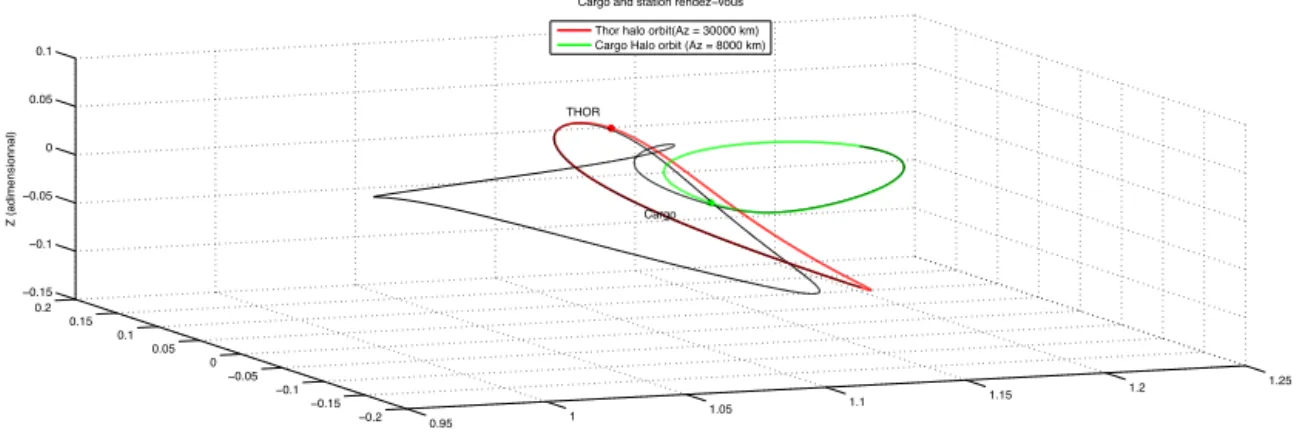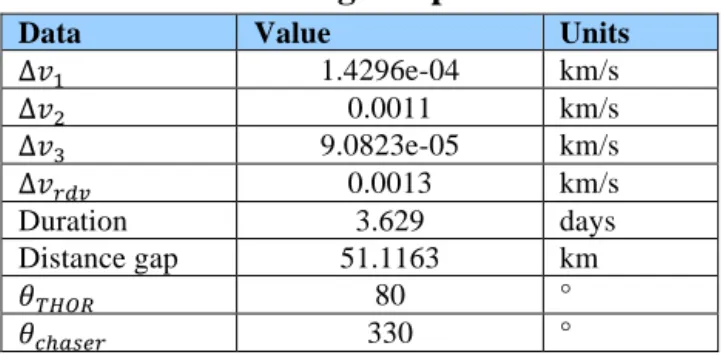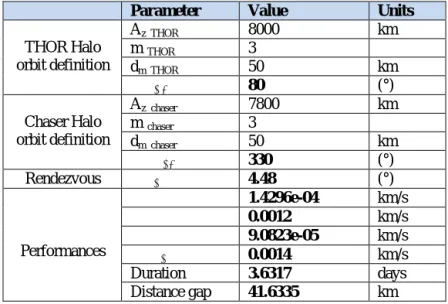To cite this version : Lizy-Destrez, Stéphanie Rendez vous optimization with an inhabited space station at EML2.
In: Proceedings of 25th International Symposium on Space Flight Dynamics ISSFD 2015, 19 October 2015 - 23 October 2015 (Munich, Germany).
O
pen
A
rchive
T
OULOUSE
A
rchive
O
uverte (
OATAO
)
OATAO is an open access repository that collects the work of Toulouse researchers and makes it freely available over the web where possible.
This is an author-deposited version published in : http://oatao.univ-toulouse.fr/
Eprints ID : 14385
Any correspondance concerning this service should be sent to the repository administrator: staff-oatao@listes-diff.inp-toulouse.fr
RENDEZVOUS OPTIMIZATION WITH AN INHABITED SPACE STATION AT EML2
(1) Stéphanie LIZY-DESTREZ(1)
(1)
ISAE-Supaero, 10 avenue Edouard Belin – 31055 Toulouse - France, +33 5 61 33 80 97, Stephanie.lizy-destrez@isae.fr
Abstract:
In the context of future human space exploration missions in solar system and according to the roadmap proposed by ISECG (International Space Exploration Coordination Group), a new step could be to maintain as an outpost, at one of the libration points of the Earth-Moon system, a space station that would ease access to far destinations as Moon, Mars and asteroids and would allow to test some innovative technologies, before employing them for far distant human missions. One of the main challenges will be to maintain permanently and ensure on board crew survival. Then the main problem to solve is to manage the station servitude, during deployment (modules integration) and operational phase.
The main challenges of this project lie in the design of the operational scenarios and, particularly, in trajectories selection, so as to minimize velocity increments (energy consumption) and transportation duration (crew safety). Transfer trajectories have already been deeply studied, since the 1950s. The work presented in this paper focuses on the feasibility of rendezvous in the vicinity of Earth-Moon Lagrangian Point n°2 (EML2) by comparing several rendezvous strategies and by providing quantitative results for a cargo or a human spacecraft (chaser) with the space station (target).
Keywords: Three-Body Problem, Lagrangian Point, Rendezvous, Halo orbit, optimization
1. Introduction
Space exploration takes an active part in the Humanity evolution, as an answer to the human desire for discovery and conquest. In the coming decades, setting up human missions for new space exploration of the solar system will be an ambitious challenge for the entire humanity. Human and robotic exploration of the Moon, Near Earth Objects (NEOs), and Mars will strengthen and enrich humanity’s future, bringing nations together for a common cause, revealing new knowledge, inspiring people, and stimulating technical and commercial innovation. These are the substantial benefits delivered to society.
Placing humans in space for a long duration mission beyond Earth's neighborhood implies the design of a highly complex system to travel, live and work safely in the hostile deep space environment. Thanks to lessons learned acquired since Apollo missions, first robotics missions towards Mars or asteroids, and exploitation of the International Space Station (ISS), a next step might be to set up a permanent outpost in the Earth-Moon system. This gateway could also serve for test bed for missions to Near Earth Objects (NEOs), lunar surface and Mars.
Main space agencies (like NASA, ESA, JAXA, Roscosmos…) participating in ISECG (International Space Exploration Coordination Group) have defined a long-range human exploration strategy, beginning with the utilization of ISS and expands human presence throughout the Solar System and leading to human missions to explore the surface of Mars. The
Global Exploration Strategy [1] also identified the common goals, among all the nations, for space exploration.
At ISAE-Supaero a research project to design such a space station has been initiated [2], that mainly focuses on the station architecture [3], called THOR (for Trans-lunar Human explORation) and the entire trajectory optimization. Several scenarios to reach EML neighborhood from the Earth (Station deployment, crew rotation, cargo transportation) have been identified, corresponding to different types of transfers (lunar flyby, weak stability boundary trajectories). Trajectory optimization in the three-body problem is a very well known subject, largely described in literature since Farquhar’s first publication [4]. Nevertheless, the rendezvous problem in the vicinity of the Lagrangian points has rarely been addressed (except [5], [6]). Yet, in the studied scenarios, rendezvous strategy is a crucial step in the optimization of the transfer from Low Earth Orbit (LEO) to Earth-Moon Lagrangian Point (EML). The main contribution of the current paper is to propose a methodology developed to optimize the rendez-vous of a cargo with an inhabited space station located at EML2.
The first part of this paper describes the project context with mission analysis results and space station architecture. In the second paragraph, the theoretical background of the three bodies problem and rendezvous are reminded. The third part deals with the methodology set up to compute rendezvous performances (velocity increment, total duration) for various studied scenarios. It is completed by the fourth part, focusing on the rendezvous expected results.
2. The THOR Space station context
According to [1], a space station located in the vicinity of the Earth-Moon Lagrangian points has many advantages. First, it can serve as a gateway to other promising destinations (Moon, asteroids, Mars...) in the solar system, being linked to them by low-cost trajectories. Moreover, some appropriate orbit around the Lagrangian points n°1 and n°2 would ensure a continuous line-of-sight communications between Earth and Moon basement (even on the far side in case of EML2). Actually, the far side, which would be easily available for the first time in human space flights history, has been suggested as an advantageous location for a radio observatory, as it would be protected from radio interference with Earth. The absence of spatial debris and of the terrestrial inhomogeneous gravitational field makes a cheaper station-keeping strategy possible. The Moon could be the first place where humans learn to live on another celestial body. This intermediate step to long-range missions is strongly recommended, firstly for financial aspects reasons and then to prove technical issues. Just three days from Earth, the Moon’s natural resources and low gravity make it an ideal location to prepare people and machines for venture further into space. As a remnant of four billion years of Solar System history and as a place to observe the Earth and the Universe, it has great scientific potential. Exploration of the Moon will also reveal whether the resources available in space will allow humans to live off the land.
Given the future human space destinations en route to Mars, i.e. deep space-habitats at Earth-Moon Lagrange points, lunar bases and asteroids, the main psychosocial and psychological issues are concerning the adverse effects of prolonged co-living and co-working in small groups, under conditions of confinement and isolation. In planning any human long duration mission beyond LEO with unprecedented crew autonomy level, basic human needs cannot be underestimated. Hence the integration of habitability issues in the very early stages of the mission design is essential to its outcome. This will result in a good prediction of the crew adaptation to deep space extreme conditions as well as the teamwork and social interactions.
Anyway, one significant challenge for a sustainable and long lasting human presence in the deep space will be to maintain the astronauts’ health by providing medical support reaching from advanced radiation monitoring to quarantine and surgery in this remote environment.
2.1. Rationales for THOR location
Due to the natural dynamics of the solar system, the two collinear Lagrangian points of the Earth-Moon system, EML1 and EML2, are considered. The concepts of Lagrangian point and Halo orbit are briefly reminded in paragraph 3. As presented on Figure 1, the space station would thus allow efficient access not only to the lunar surface, but also to many interesting destinations in the solar system like, for example, the Sun-Mars L2 or the Sun-Jupiter L1….
Figure 2: THOR space station location
Both Lagrangian points are at about the same distance from the Moon but EML2 is almost one third further away from Earth than EML1. This induces considerable differences in access cost and transfer time. Nevertheless, trade-off analysis has been conducted, comparing four possible couples, composed by location (EML1 or EML2) and type of orbit (Lissajous or Halo). The results, detailed in [2], recommend placing the THOR Space Station on Halo orbit around EML2.
2.2. THOR life-profile
The main challenges of the THOR project lie in the deployment and operation phase. This implies to take into consideration the entire trajectory not only for the Space station modules but also for its resupply vehicle (for crew and for cargo). Even if the expected performances (in term of duration and fuel consumption) vary from one phase to the other, the main legs of the cargo and the crew trajectories remain the same: Launch, station keeping in LEO (1), transfer (2), rendezvous (3), station keeping on the Halo orbit (4), return (5) and re-entry (6) as it is described on figure 2.
Figure 3: Trajectories main legs 2.3. THOR architecture
Taking into account all Stakeholders’ needs ([2], [3]), the inhabited space station has been then designed. The architecture is mainly composed of seven cylindrical modules based on ATV (Automated Transfer Vehicle) proportions (a mass of twenty tons, a diameter of five meters and a length of ten meters each), completed by two spherical nodes. Each cylindrical module supports a specific function (as room, offices, kitchen, medical center, cult area...) while the spherical nodes are added to ease displacements inside the station, offer windows on space, like the Cupola on board the ISS, and support docking port. In order to avoid traffic congestion, spherical modules have been placed at the intersection of the three modules of the northern part and the three of the southern parts. These spherical modules can be compared to a crossroad and would function much the same as hubs. Windows would be added to their top parts to allow celestial viewing.
The following picture depicts the THOR station functions allocation.
Figure 4: THOR station configuration
This functional repartition was established in order to reproduce the terrestrial way of life. As the context of the THOR (location, orbit type and Space station architecture) project has been defined, next paragraph will deal with the theoretical background of the Three-body problem and the rendezvous.
3. The theoretical background
This paragraph gives not only an overview of the state-of-the art of the three-body problem, so as to explain what the Lagrangian points are, but also a description of the dynamics in their vicinity, that is to say the way to travel to or from the Lagrangian points and finally, provides some theoretical background for rendezvous.
3.1. The CR3BP model
The N-body problem consists in the prediction of the motion of a particle P0, under the
gravitational influence of N-1 massive bodies 𝒫!… 𝒫! with respective masses (m1…. mN-1)
and their respective positions (P1…. PN-1). In general, the massive bodies are the celestial bodies
(like Earth, Moon, Sun…) and the particle is the spacecraft, like in this study, the Station, the cargo or the crew vehicle. The massive bodies are called the primaries. As the N bodies are isolated (no other effect), the problem can be described by the following equations, developed in
ℜ!, the Galilean reference frame:
𝑚!! !!!! !"! = !!!!!! −𝐺 !!! !!!! !!!! !𝑃!𝑃! 𝑘 = 0 … . 𝑁 − 1 (1) Where
O is the origin of the reference frame G is the gravitational constant
The mathematical model to represent the Earth-Moon dynamical environments is the Circular Restricted Three-Body Problem (CR3BP), commonly used to produce quick and efficiently quantitative results for transfers between Earth and libration orbits. While the two-body problem has entirely been solved, the three-body problem does not admit any analytical solution. When the particle is assumed to be massless, the problem is said to be “Restricted.” This means that the motion of the particle will not affect the trajectories of the primaries. The model becomes the Circular Restricted Three-Body Problem (CR3BP) when the primaries are supposed to be on circular orbits about their common center of mass. The Three-Body Problem has been deeply
detailed in many publications. This manuscript mainly refers to [7].
In order to simplify the expressions (1), the masses, distances and time are normalized respectively with the sum of the primaries’ masses, the distance between them and their angular velocity around their barycenter. The unit of time is taken such that the period of the orbits of the
primaries is 2π. The equations are written in the synodic frame, centered on the center of mass
and with the x-axis directed from the Earth to the Moon and the y-axis in the plane of the primaries’ motion (Figure 5) the z-axis completes the right hand system. Then, the universal
Figure 5: Inertial and rotating reference frames The well-known equations of motion, once simplified are:
𝑥 − 2𝑦 = −𝑈! = − 𝜕𝑈 𝜕𝑥 𝑦 + 2𝑥 = −𝑈!= − 𝜕𝑈 𝜕𝑦 𝑧 = −𝑈!= − 𝜕𝑈 𝜕𝑧 (2)
Where, 𝑈 is the effective potential:
𝑈 𝑥, 𝑦, 𝑧 = −1 2 𝜇!𝑟!!+ 𝜇!𝑟!! − 𝜇! 𝑟! − 𝜇! 𝑟! (3)
Where r1 and r2 are the distances of the particle P, from the two celestial bodies, M1 and M2, with
respective mass m1 and m2, with m2 < m1.. The negligible mass of the particle is m3.
The mass parameter, µ, is defined as:
𝜇 = 𝑚! 𝑚!+ 𝑚!
(4)
Where 𝜇 ∈ 0,!
!
Then, let: 𝜇!= 1 − 𝜇 and 𝜇!= 𝜇 (5)
3.2. Families of libration orbit
In this context, Lagrangian points are locations where gravitational pulls and centrifugal force are balanced. Joseph Lagrange demonstrated in 1772 (see [8]), that five points could be found. For example, in the Earth-Moon system, they are called EML1 to EML5. By consequence, Lagrangian points, as equilibrium points of the three-body problem, are interesting, as final location or waypoint on the road to further destinations, since they required low energy to be reached and to maintain the orbit in their vicinity. Four different kinds of orbits exist around libration points and are designated as: the Lyapunov orbits, Lissajous orbits, Halo orbits and the Quasi-Halo orbits.
As the CR3BP cannot be solved analytically, methodologies with high order approximations have been set up and presented by K. Howell [9], G. Gòmez and J. Masdemont ([10], [11]). While selecting carefully the initial conditions, the solution of the linearized equations of motion are then: 𝑥 = −𝐴!cos 𝜔!𝑡 + 𝜙 𝑦 = 𝜅𝐴!sin 𝜔!𝑡 + 𝜙 𝑧 = 𝐴!cos 𝜔!𝑡 + 𝜓 (6) Where
Ax, Az, κ, φ and ψ are constant, depending on the initial conditions,
±𝜆, ±𝑖𝜔!, ±𝑖𝜔!" are eigenvalues of the system In the particular case of the Halo orbit, it is assumed that:
𝜔!= 𝜔! (7)
That leads to the conclusion that a Halo orbit is fully defined by two parameters: Az and m,
where m defines the family of solutions, i.e. m=1 for Northern Halo orbits, while m=3 for Southern Halo orbits. From the expression of the solutions, it can be concluded that a small variation of the trajectory can cause a small component along x and y axis and the trajectory becomes unstable. This concept is then used to compute trajectories that converge towards the orbit around the Lagrangian point (stable manifold) and departs from the orbit (unstable
manifold). To compute the invariant manifolds, the equations of motion can be propagated.
Figure 6 shows an example of the projection onto the position space of the stable (green) and unstable (red) manifolds of an EML2 southern Halo orbit (blue) with an amplitude Az = 5000 km. The manifolds are trajectories, solutions of the system of motion equations.
Figure 6: Stable (green) and unstable (red) manifold for an EML2 southern Halo orbit (Az = 5000 km) 0 100 200 300 400 500 600 −300 −200 −100 0 100 200 300 X (x 103 km) Y (x 10 3 km) Earth Moon
3.2- End-to-end transfer strategies
As far as transfer strategy is concerned, a wide literature already exists and enlightens that four main strategies are possible: the direct transfer, the indirect transfer, the lunar flyby and the weak stability boundary transfer. The first three strategies fit into the Earth-Moon Three-Body Problem, whereas the last one patches two Three-Body problems. Bibliographical survey led to compare transfer strategies. Results are provided on fuel cost as a function a time of flight, on figure 7.
Figure 7: Comparison of transfer strategies: fuel cost as a function of the time of flight [12]
The main recommendations from this survey are to consider a lunar flyby for human spaceflight (crew vehicle trajectories) and Weak Stability transfer for unmanned system (Station modules and cargo).
3.3. Rendezvous state-of-the art
JC Houbolt [13] defines the rendezvous as:
"the problem of rendezvous in space, involving, for example, the ascent of a satellite or space ferry as to make a soft contact with another satellite or space station already in orbit." The vehicle that is already in orbit is commonly called the target, while the one that is arriving, is named the chaser. The different phases and maneuvers of a typical rendezvous mission from the launch until the docking to the target spacecraft have been extensively studied from Apollo missions to ISS resupply missions. They are mostly named: launch, transfer, orbital injection, phasing and proximity maneuvers (including homing, closing and final approach). Rendezvous is then followed by docking or berthing, depending on the type of the chaser.
The rendezvous operations that are considered in this study start from the departure of the chaser from its parking orbit to the injection maneuver onto the target orbit in the vicinity of the
Earth-20 40 60 80 100 120 140 3000 3200 3400 3600 3800 4000 4200
Time of flight (days)
∆ Vtot (k m /s ) Direct Transfers Lunar Flyby Transfers WSB Transfers Indirect Transfers
Manned spaceflights
final orbit are out of the scope of this project. Nevertheless, the main goal of the rendezvous is to conduct the chaser relatively close to the target in order to linearize the equations of motions of both vehicles until the contact.
By assuming the THOR space station on a Halo orbit, the delivery cargo or crew vehicle tends to join THOR. The chaser may either start the rendezvous from a manifold or from on a Halo
parking orbit. According to [7], depending on the location of the chaser, two different types of
rendezvous could be performed:
- The HOI (Halo Orbit Insertion): the chaser is parking on a particular Halo orbit (defined by Az_chaser, m_chaser),
- The MOI (Stable Manifold Orbit Insertion): the chaser travels from the Earth on the
stable manifold of the Halo orbit of the THOR space station. The Figure 8 illustrates both concepts.
Figure 8: Rendezvous concepts
By consequence, the rendezvous operations would include the following steps:
- Parking: the initial state. The THOR space station is orbiting on another Halo orbit
(defined by Az_THOR, m_THOR). The chaser is either arriving on the stable manifold, either
parking on a Halo orbit.
- Departure: a first maneuver (∆𝑣!) is applied to the chaser so that it would leave its
Halo orbit and travel on the unstable manifold in the MOI case. There is no departure in HOI case.
- Intermediate maneuver: In MOI case, a second maneuver (∆𝑣!) is applied at the
intersection between the unstable manifold of the cargo Halo orbit and the stable manifold of the THOR Halo orbit, so that the chaser trajectory is reoriented. There is no final maneuver in HOI case.
- Final maneuver: a last maneuver (∆𝑣!) is performed so that the chaser would leave
the stable manifold to reach the THOR space station Halo orbit.
- Phasing: As soon as the chaser and the station are rotating on the same Halo orbit,
phasing operations could take place so as to ease docking maneuvers: both vehicles must be as close as possible so as to linearize their equations of motions.
The operations are summed up on the following schema (with eFFBD modeling). Only processes are given. Data flows have not been detailed for simplification.
Figure 9: Rendezvous operations sequence
The most critical part of the rendezvous mission lies in the proximity operations phase (phasing) when the distance between the chaser and the target is below a small distance (some kilometers). Safety is the overriding design consideration for automated missions towards inhabited facility. To avoid collision and accident, corrections maneuvers must be performed before this final step. This is why the chaser trajectory must be computed with a very high accuracy. The phasing activities are not presented in the project, but it is an interesting extension opportunity, while
referring to E. Canalias [5]. She suggested simple equations to manage the phasing on Lissajous
orbits that could be adapted to Halo orbits.
As a consequence, the rendezvous design parameters are: - HOI or MOI: initial situation of the chaser
- Az_THOR : Maximal elongation along z-axis of the Halo orbit of the THOR space
station
- Az_chaser: Maximal elongation along z-axis of the initial Halo orbit of the chaser
- m_THOR: Halo family of the THOR space station
- m_chaser: Halo family of the chaser
- 𝜃!"#$: Initial angular position of the THOR space station on the Halo orbit when rendezvous starts
- 𝜃!!!"#$: Initial angular position of the chaser on the Halo orbit when rendezvous starts
Analysis of all the possible situations led to identify at least thirteen cases. The focus is set on the modeling and analysis of the Halo-to-Halo rendezvous. Two different Halo orbits are never coplanar. Actually, due to unpredictable miscellaneous or discrepancies during previous steps of the trajectory (launch, LEO and transfer), it seems not realistic that the chaser will reach perfectly the Halo orbit of the THOR space station, even if the targeted Halo orbits are the same (same Az, same m). It is then assumed that the cargo will not arrive directly on THOR orbit. This does mean that every listed situation should finally come to perform a rendezvous at least two
maneuvers: a first maneuver to leave the current trajectory and a second maneuver to get on the target Halo orbit. The algorithm of this strategy is detailed in next paragraph.
A focus is set on a Halo-to-Halo transfer, while assuming THOR already orbiting around EML2 (due to mission requirements). But every type of rendez-vous (Lissajous-to-Halo, Lyapunov-to-Halo…) should be investigated.
5. Rendezvous methodology
The previous synthesis shows that performing the rendezvous between a chaser and the THOR station always corresponds to a heteroclinic connection between two Halo orbits, by finding the intersection between their manifolds (the unstable manifold for the cargo and the stable manifold for the station), except when only the phase has to be changed. The focus is set on the HOI configuration, with different Az. The main step of the proposed rendezvous process lies in the intersection of two manifolds thanks to a Poincaré section. It falls into five main steps:
- Step 1: To compute the chaser Halo orbit and unstable manifold
- Step 2: To compute the THOR space station Halo orbit and stable manifold
- Step 3: To find the optimal intersection between both manifolds thanks to a Poincaré
section
- Step 4: To compute the chaser entire rendezvous trajectory from its Halo orbit to the
Station orbit
- Step 5: To estimate the rendezvous performances (total delta-v, duration)
This process imposes additional design parameters, let free for the optimization:
- dM_THOR: Distance between the THOR space station Halo orbit and the manifold
- dM_chaser: Distance between the chaser Halo orbit and the manifold
- 𝜙!"#: Poincaré section position
The Figure 10 provides a 3D example of a Halo-to-Halo rendez-vous strategy, with the THOR space station Halo orbit defined by (Az_THOR = 30000 km, m_THOR = 1) and a chaser Halo orbit defined by (Az_chaser = 8000 km, m_chaser = 3).
Figure 10: Example of rendezvous strategy between a chaser and the THOR space station The chaser is first rotating on its Halo orbit (green leg), then escapes on the unstable manifold (first black leg) to a first impulsive maneuver. At the intersection between chaser unstable manifold and station stable manifold, on the Poincaré section, the chaser enters the station stable
0.95 1 1.05 1.1 1.15 1.2 1.25 −0.2 −0.15 −0.1 −0.05 0 0.05 0.1 0.15 0.2 −0.15 −0.1 −0.05 0 0.05 0.1 X (adimensionnal) Cargo and station rendez−vous
Y (adimensionnal)
Z (adimensionnal)
Thor halo orbit(Az = 30000 km) Cargo Halo orbit (Az = 8000 km)
THOR
manifold thanks to a second impulsive maneuver and then glides until it reaches the Station orbit. During this phase, the THOR station keeps on traveling on its Halo orbit.
6. Rendezvous performances
The performance of the rendezvous strategy is evaluated thanks to two criteria: the total delta-v and the total duration.
The total delta-v for the rendez-vous is computed as:
∆𝑣!"# = ∆𝑣!+ ∆𝑣!+ ∆𝑣! (8)
Where
• ∆𝑣! is the necessary burst to enter the unstable manifold from the chaser initial Halo orbit
• ∆𝑣! is the burst to leave the unstable manifold to get on the stable manifold
• ∆𝑣! is the required final burst to leave the stable manifold to join the THOR Halo orbit
The cost function for the optimization process is a combination of the distance between the two
manifolds and the velocity gap at this point, since ∆v! is the most critical maneuver. The
distance has to be as low as possible:
• First, to explore only physical and feasible trajectories (no teleportation is allowed)
• Then, to limit the rendezvous duration, since it is a direct consequence of this distance.
This cost function is robust, since there is no discontinuity as far as the local step of the optimization process is concerned. The cost function expression is quite simple, but the constraints are complex due to non-linear dynamics of the system.
6.1. Rendezvous initial guess
Simulation campaigns were run to select the best initial guess, assuming that Az_THOR is set equal
to 8000 km. It has been noticed that the difference between both elongations has a bad impact on
∆v!. Thus, it is better to select an Az_chaser between 7500 km and 7900 km, or over 8400 km. As a
consequence Az_chaser has been set equal to 7800 km. Analysis of the influence of the position of
the Poincaré map led to fix it to 𝜙!"# = 4.4 °.
Then, performances obtained for the rendez-vous are:
Table 1: Initial guess performances
Data Value Units
∆𝑣! 1.4296e-04 km/s ∆𝑣! 0.0011 km/s ∆𝑣! 9.0823e-05 km/s ∆𝑣!"# 0.0013 km/s Duration 3.629 days Distance gap 51.1163 km 𝜃!"#$ 80 ° 𝜃!!!"#$ 330 °
According to the total delta-v and duration, this initial guess is really promising. The instantaneous jump in space is about 51 km. It is reminded that the limit for linearization is considered to be equal to 50 km. Optimization process will then aim at reducing this distance without degrading the total delta-v and duration
6.2 Rendezvous influence analyses
Results are encouraging, but not optimal, in particular, because the gap in distance at the intersection of both manifolds on the Poincaré Map is too high. Then, complementary analyses have been conducted to evaluate:
- The influence of the weights of the cost function
- The influence of the initial angular positions on both Halo orbit
The main conclusion is that the performances of the rendezvous definitely depend on the initial angular positions on both Halo orbit, that is to say (𝜃!"#$, 𝜃!!!"#$). Best rendezvous will be found in a scenario when 𝜃!"#$ and 𝜃!!!"#$ are on opposite sides of the Poincaré map. Moreover, the
optimal scenario corresponds to the case with the Poincare map tangent to the Halo orbit at one of its extrema along the y-axis
6.3 Rendezvous optimization algorithm
The following process has then been developed to select the optimal scenario for a rendezvous with THOR space station (when Az_THOR, m_THOR, Az_chaser, m_chaser) are already fixed:
- Step 1: To compute the THOR and chaser Halo orbits
- Step 2: To minimize the gap of distance at Poincare map when 𝜙!"# is varying.
- Step 3: When 𝜙!"# is fixed, to optimize rendezvous total delta-v when (𝜃!"#$, 𝜃!!!"#$) are let free.
- Step 4: To compute the optimal rendezvous performances (duration, distance gap and total delta-v)
Resulting performances comply with the given requirement:
- Distance gap at Poincaré lower than 50 km - Low total delta-v
- Low duration (about three days)
The recommended strategy is then summed up in the following table, where Bolded values come out the optimization process. Figure 11 presents the entire rendezvous trajectory from chaser
Halo orbit (Az_chaser = 7800km, m_THOR = 3) to THOR Halo orbit (Az_chaser = 8000km,
Table 2: Example of Halo-to-halo rendezvous strategy performances
Parameter Value Units
THOR Halo orbit definition Az_THOR 8000 km m_THOR 3 dm_THOR 50 km 𝜃!"#$ 80 (°) Chaser Halo orbit definition Az_chaser 7800 km m_chaser 3 dm_chaser 50 km 𝜃!!!"#$ 330 (°) Rendezvous 𝜙!"# 4.48 (°) Performances ∆𝑣! 1.4296e-04 km/s ∆𝑣! 0.0012 km/s ∆𝑣! 9.0823e-05 km/s ∆𝑣!"# 0.0014 km/s Duration 3.6317 days Distance gap 41.6335 km
On the next graph, the two Halo orbits (the green for the chaser and the red for THOR) are almost mixed since both elongations are not really different
Anyway, it can be noticed that the Poincaré map is almost tangent to the THOR Halo orbit. This strategy was selected since it minimizes the distance gap at the Poincaré map. The feasibility criterion is considered to be the most important. Actually, some other strategies could be proposed with lower duration or lower total delta-v. As a consequence, when the crew vehicle mission is concerned, different rendezvous trajectories can be selected so as to reduce the duration, even if the total delta-v would increase.
The main results analyses performed for the rendezvous with the THOR space station on a Halo orbit around EML2 are:
- First, Az_chaser, the maximal elongation of the Halo orbit of the chaser along the z-axis,
should be close to Az_THOR. For example, withAz_THOR= 8 000km, it is recommendedto
select Az_chaser in the range of [7 500 km; 7 900 km ].
- Secondly, the position of the Poincaré map must be carefully selected. It will impose the location where the vehicle will change from the unstable stable manifold leg to the stable manifold leg. In the case where Az_THOR= 8 000km, it can be suggested to fix it in the
range of [-4.5°; 4.5°]. As, the problem is symmetrical; its study can be limited to the positive values of 𝜙!"#.
- Thirdly, the angular positions on both Halo orbit, 𝜃!"#$ and 𝜃!!!"#$are decisive for the rendezvous performances. It has been concluded that 𝜃!"#$ and 𝜃!!!"#$should be on both sides of the Poincaré map.
- At last, the Poincaré map should be almost tangent to the THOR Halo orbit at its maximal position along the y-axis.
Those recommendations lead to define precisely the rendezvous strategy so as to find the best compromise between the duration, the cost (in term of delta-v) and teleportation (distance gap at the Poincaré map). Those analyses were restricted to the HOI case, with two Halo orbits belonging to the same family. Some further simulations led to the conclusions that rendezvous from a Lyapunov orbit to a Halo orbit are not worthy. Anyway, it could be really interesting to study deeply all the possible combinations of rendezvous (and more particularly the MOI strategies), to get better knowledge on heteroclinic rendezvous in the vicinity of a Earth-Moon Lagrangian points.
Until now, all the performances were computed separately (leg by leg). t is nevertheless worthy to consider the interaction between transfer and rendezvous. Two situations must be considered:
- First, the crew vehicle scenario that includes a lunar flyby transfer and a Halo-to-Halo rendezvous
- Secondly, the cargo delivery scenario with a WSB transfer and a Halo-to-Halo rendezvous
7. Conclusion
The next steps for future human space exploration of the solar system could be to operate a space station in the vicinity of the Earth-Moon Lagrangian points. This outpost would not only facilitate connections with further destinations like Mars or NEOs, but also support missions on the Moon surface. It would also procure facilities to test innovative technologies and activities and to ensure crew well being.
In the context of the THOR project, this paper has proposed methodology perform the rendezvous at EML2. Actually, whatever the transfer strategy is, rendezvous is mandatory for THOR mission to manage safe human activities during at least fifteen years. In the past five decades, only very few research teams took an interest in rendezvous in the neighborhood of the Lagrangian points. The strategy proposed for the THOR project is an extrapolation of heteroclinic connections usually set up to transfer a particle from one Lagrangian point to another one. Assuming that the chaser (station module, cargo or crew vehicle) is waiting on a Halo parking orbit different from the space station ones, rendezvous composed of three maneuvers would deposit the chaser on the station Halo orbit. The final maneuvers to perform the docking are not taken into account. Optimization processes applied to the proposed methodology led to affordable trajectories as far as duration and energy consumption are concerned. Moreover, those solutions are compliant with human spaceflight safety constraints, ensuring permanent communications with the crew during those critical operations and offering station keeping points for go/no go before next step.
However, the THOR project tried to be as complete as possible, it cannot pretend to be exhaustive. It was the intention to open the path for extended research studies. For example, the selection of crew transfer trajectories shall be correlated to operational constraints (permanent communications, safety, launch window, rendezvous opportunity, contingencies…). As this project was limited to the CR3BP model, it seems to be obvious to try to transpose it to a more accurate model (like the Four-body problem or the application of ephemeris). Third, the rendezvous methodology proposed in this project is a first step in the understanding of rendezvous dynamics in the vicinity of Lagrangian points. Further analyses should be undertaken to complete those preliminary results, while considering combination of orbits or with a departure point in the stable manifold of the station orbit. It could also offer an extension to look at connections from Earth-Moon Lagrangian point to Mars system, in the context of future human spaceflight.
Finally, the THOR project finds fresh hope to invite the international human spaceflight community to support the next steps for exploration mission towards the Earth-Moon Lagrangian points, as a safe oasis on the road to far destinations.
8. References
[1] ISECG, Global Exploration Roadmap, August 2013
[2] Stéphanie Lizy-Destrez, C. Blank, Mission analysis for a Space Medical Center of an
exploration gateway at a lunar libration point, IAC-11.A5.4.8 - IAC 2011 - 3- 7 October 2011 Cape Town - South Africa
[3] Stéphanie Lizy-Destrez, Giuseppe Ferraioli, Chloé Audas, Jason Piat, How to save
delta-V and time for a round trip to EML2 Lagrangian point? IAC-12.A5.4.12, - IAC 2012 - 1-5 October 2012 Naples – Italy
[4] Farquhar, R. W. Station-keeping in the vicinity of collinear libration points with an
application to a Lunar communications problem, in Space Flight Mechanics, Science and Technology Series, volume 11, pages 519-535, American Astronautical Society, New York
[5] E. Canalias and J. Masdemont, Rendez-vous in Lissajous orbits using the effective phase plane, IAC-06-C1.8.03, 2006.
[6] B.L. Jones, R.H. Bishop, Rendezvous Targeting and Navigation for a Translunar Halo
Orbit. Journal of Guidance, Control and Dynamics, 17(5): 1109{1114, 1994.
[7] Koon, W. S., et al. Dynamical Systems, the Three-Body Problem and Space Mission
Design. Free online Copy : Marsden Books, 2008.
[8] Lagrange J-L, 1772, Essai sur le problème des trois corps, Prix de l’Académie Royale des
Sciences de Paris, tome IX, in vol. 6 of Oeuvres de Lagrange , Gauthier –Villars, Paris 1873, 272-282
[9] Howell, K., Three-dimensionnal, periodic, ‘Halo’ orbits, Celestial mechanics, 1984
[10] Gómez, G., W. S. Koon, M. Lo, J. E. Marsden, J. Masdemont, and S. D. Ross, Invariant
manifolds, the spatial three-body problem and space mission design, Adv. Astronaut. Sci. 109, 3–22, 2001
[11] Gómez, G., W. S. Koon, M. Lo, J. E. Marsden, J. Masdemont, and S. D. Ross, Connecting orbits and invariant manifolds in the spatial three-body problem, Nonlinearity, 17, pp. 1571-1606, 2004
[12] Kokou, P, Le Bihan, B., Jean-Baptiste Receveur, Stéphanie Lizy-Destrez, Computing an optimized trajectory between Earth and an EML2 halo orbit, SciTech 2014, 13-17 National Harbor, Maryland, USA
[13] Houbolt, J. C., Considerations of the Rendezvous Problems for Space Vehicles, April 1960
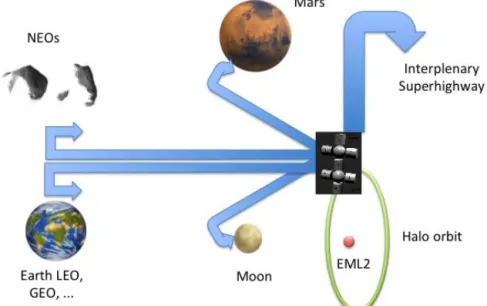
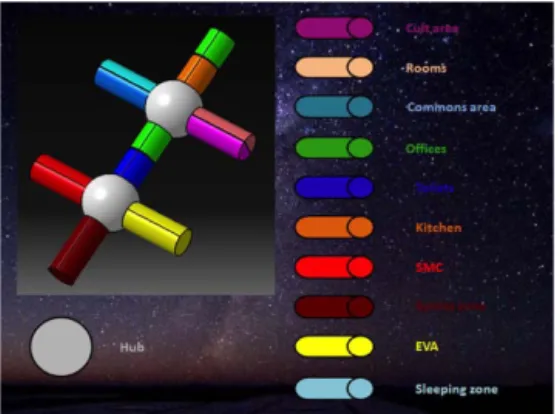
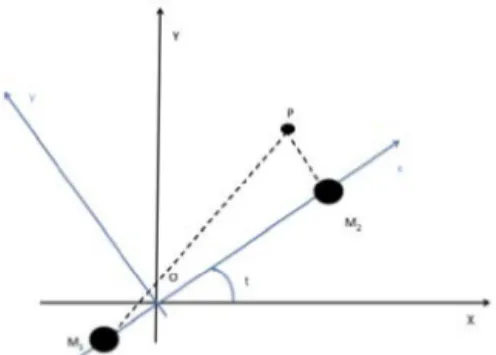
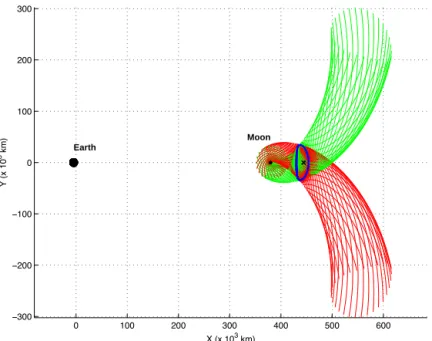
![Figure 7: Comparison of transfer strategies: fuel cost as a function of the time of flight [ 12]](https://thumb-eu.123doks.com/thumbv2/123doknet/3227883.92365/9.918.302.697.303.612/figure-comparison-transfer-strategies-fuel-cost-function-flight.webp)


